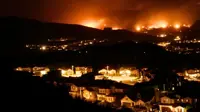Now, scientists fear smallpox outbreak as permafrost melts
16 Aug 2016
Russian scientists are warning of the threat of born-again smallpox re-emerging from graves in the Arctic where permafrost is melting due to climate change .
 In some areas of Siberia, the thawing is three times greater than usual, risking the re-awakening of deadly diseases.
In some areas of Siberia, the thawing is three times greater than usual, risking the re-awakening of deadly diseases.
The new alert comes after an outbreak of deadly anthrax in the Yamal peninsula last month which killed one child and led to 24 more with confirmed infections. More than 2,300 reindeer perished in the outbreak (See: Global warming could unleash diseases not seen since Ice Age).
The anthrax infection is believed to have spread after the thawing of reindeer or even human graves but now scientists warn the same process could release smallpox, a disease that has been eradicated in the world.
"Can these processes repeat themselves? Of course they can," warned Boris Kershengolts, deputy director for research at the Institute for Biological Problems of the Cryolithozone in Yakutsk.
"Back in the 1890s, there occurred a major epidemic of smallpox - there was a town where up to 40 per cent of the population died,
"Naturally, the bodies were buried under the upper layer of permafrost soil, on the bank of the Kolyma River (in eastern Siberia).
"Now, a little more than 100 years later, Kolyma's floodwaters have started eroding the banks."
Virus experts from the Siberian branch of the Russian Academy of Sciences have visited the graves, said Professor Sergey Netesov, of Novosibirsk State University.
The corpses they studied bore sores that looked like those smallpox might cause, he told video conference called in the wake of the anthrax outbreak.
While the virus itself was not found, some fragments of its DNA were noted, reported The Siberian Times.
"This type of research should go on," he urged. "Examining deeper burials might help clear up the situation."
The tsarist Arctic fortress town of Zashiversk, totally abandoned in 1898 after repeated smallpox outbreaks, is one example of a site where graves could pose a modern threat.
Graves containing smallpox victims are melting because of climate change
Apart from anthrax and smallpox, there are many other dangers lurking in shallow Arctic graves which might be unlocked from the ice after centuries, warned Viktor Maleyev, deputy chief of Russia's Central Research Institute of Epidemiology.
Scientists are discovering new "giant viruses" in woolly mammoths, the carcasses of which are appearing as warmer weather melts ice and permafrost, he said.
"Their pathology has not been proven, we must continue to study them.
"I think climate change will bring us many surprises," he said. "I don't want to scare anyone, but we should be ready."
Another expert warned that the melting in northern Siberia is far greater than expected this summer.
The depth of thawing in the Yakutia, Russia's largest region, is usually 30-to-60 centimetres, while this year it has exceeded one metre, said deputy director of the Permafrost Studies Institute, Mikhail Grigoriev.
"The rock and soil that forms the Yamal Peninsula contains much ice," he said.
"Melting may loosen the soil rather quickly, so the probability is high that old cattle graves may come to the surface.
"Some graves dug in the past may be just three meters deep, covered by a very thin layer of soil.
"The spores of the (anthrax) disease are now on the loose."



.webp)
.webp)

.webp)
.webp)

























